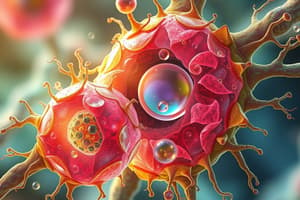Podcast
Questions and Answers
What feature distinguishes prokaryotic cells from eukaryotic cells?
What feature distinguishes prokaryotic cells from eukaryotic cells?
- Eukaryotic cells do not have ribosomes.
- Eukaryotic cells have circular DNA.
- Prokaryotic cells lack a nucleus. (correct)
- Prokaryotic cells contain membrane-bound organelles.
Which organelle is primarily responsible for ATP production?
Which organelle is primarily responsible for ATP production?
- Golgi Apparatus
- Mitochondria (correct)
- Chloroplasts
- Ribosomes
During which phase of mitosis do chromosomes align at the cell equator?
During which phase of mitosis do chromosomes align at the cell equator?
- Anaphase
- Telophase
- Prophase
- Metaphase (correct)
What is a key feature of meiosis that differs from mitosis?
What is a key feature of meiosis that differs from mitosis?
Which structure selectively controls the entry and exit of substances in a cell?
Which structure selectively controls the entry and exit of substances in a cell?
In meiosis, what process contributes to genetic diversity?
In meiosis, what process contributes to genetic diversity?
Which of the following structures is involved in lipid synthesis?
Which of the following structures is involved in lipid synthesis?
Which statement about the fluid mosaic model is TRUE?
Which statement about the fluid mosaic model is TRUE?
What distinguishes the chromosomal arrangement in eukaryotic cells compared to prokaryotic cells?
What distinguishes the chromosomal arrangement in eukaryotic cells compared to prokaryotic cells?
Which stage of mitosis follows anaphase?
Which stage of mitosis follows anaphase?
Flashcards are hidden until you start studying
Study Notes
Cell Biology
-
Definition: Study of the structure, function, and behavior of cells.
-
Cell Types:
- Prokaryotic Cells:
- No nucleus or membrane-bound organelles.
- DNA is circular and located in nucleoid region.
- Examples: Bacteria and Archaea.
- Eukaryotic Cells:
- Have a nucleus and membrane-bound organelles.
- DNA is linear and associated with histones.
- Examples: Plant and animal cells.
- Prokaryotic Cells:
-
Cell Structure:
- Plasma Membrane:
- Semi-permeable barrier controlling entry/exit of substances.
- Cytoplasm:
- Gel-like substance where organelles are suspended.
- Organelles:
- Mitochondria: Energy production (ATP synthesis).
- Ribosomes: Protein synthesis.
- Endoplasmic Reticulum:
- Rough ER: Protein synthesis and folding.
- Smooth ER: Lipid synthesis and detoxification.
- Golgi Apparatus: Modifies, sorts, and packages proteins.
- Lysosomes: Digestion of macromolecules.
- Chloroplasts (in plants): Photosynthesis.
- Plasma Membrane:
-
Cell Membrane Structure:
- Phospholipid bilayer with embedded proteins.
- Fluid mosaic model: Describes the dynamic nature of the membrane.
Cell Division
-
Purpose: To allow growth, development, and repair of tissues.
-
Types of Cell Division:
-
Mitosis:
- Produces two genetically identical daughter cells.
- Involves one cell division.
- Stages:
- Prophase: Chromatin condenses into chromosomes.
- Metaphase: Chromosomes align at the cell equator.
- Anaphase: Sister chromatids separate to opposite poles.
- Telophase: Nuclear membranes reform; chromosomes decondense.
- Cytokinesis: Division of cytoplasm.
-
Meiosis:
- Produces four genetically diverse daughter cells (gametes).
- Involves two rounds of cell division (Meiosis I and II).
- Key Features:
- Reduction in chromosome number by half.
- Genetic recombination through crossing over during Prophase I.
- Stages:
- Meiosis I: Homologous chromosomes separate.
- Meiosis II: Sister chromatids separate.
-
-
Regulation of Cell Division:
- Cell cycle checkpoints: Ensure proper division and prevent errors.
- Cyclins and cyclin-dependent kinases (CDKs): Proteins that regulate the cell cycle.
-
Significance of Cell Division:
- Essential for growth, tissue repair, and reproduction (in the case of meiosis).
- Errors in cell division can lead to cancer and genetic disorders.
Cell Biology
- Study of cell structure, function, and behavior.
- Cell Types:
- Prokaryotic Cells: Lack a nucleus and membrane-bound organelles; DNA is circular and found in nucleoid; examples include bacteria and archaea.
- Eukaryotic Cells: Possess a nucleus and membrane-bound organelles; DNA is linear and associates with histones; includes plant and animal cells.
- Cell Structure:
- Plasma Membrane: Acts as a semi-permeable barrier regulating substance entry and exit.
- Cytoplasm: Gel-like substance housing organelles.
- Organelles:
- Mitochondria: ATP synthesis, the powerhouse of the cell.
- Ribosomes: Sites for protein synthesis.
- Endoplasmic Reticulum (ER):
- Rough ER: Involved in protein synthesis and folding.
- Smooth ER: Responsible for lipid synthesis and detoxification processes.
- Golgi Apparatus: Modifies, sorts, and packages proteins for secretion or use within the cell.
- Lysosomes: Contain enzymes for digesting macromolecules.
- Chloroplasts (in plants): Sites for photosynthesis.
- Cell Membrane Structure:
- Composed of a phospholipid bilayer integrated with proteins; described by the fluid mosaic model representing its dynamic nature.
Cell Division
- Purpose: Facilitates growth, development, and tissue repair.
- Types of Cell Division:
- Mitosis: Results in two genetically identical daughter cells; single cell division.
- Stages include:
- Prophase: Chromatin condenses into distinct chromosomes.
- Metaphase: Chromosomes align at the equatorial plate.
- Anaphase: Sister chromatids are pulled apart to opposite ends.
- Telophase: Nuclear membranes reform; chromosomes decondense.
- Cytokinesis: Complete division of the cytoplasm.
- Stages include:
- Meiosis: Produces four genetically diverse gametes; involves two rounds of division.
- Key features:
- Reduces chromosome number by half, essential for sexual reproduction.
- Genetic recombination occurs via crossing-over in Prophase I.
- Stages include:
- Meiosis I: Homologous chromosomes separate.
- Meiosis II: Sister chromatids segregate.
- Key features:
- Mitosis: Results in two genetically identical daughter cells; single cell division.
- Regulation of Cell Division:
- Checkpoints in the cell cycle ensure accurate division and minimize errors.
- Cyclins and cyclin-dependent kinases (CDKs) are vital proteins that control progression through the cell cycle.
- Significance of Cell Division:
- Critical for organismal growth, tissue repair, and sexual reproduction; errors can lead to cancer and genetic disorders.
Studying That Suits You
Use AI to generate personalized quizzes and flashcards to suit your learning preferences.





